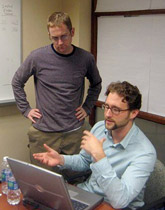A group of first- and second-year MBA students pile into a rental car, making the four-hour trip from Pittsburgh to College Park, Md. They fall into casual conversation, filling the ride with jokes and taking jabs at each other. Typically, on a Wednesday night the four students might be holed away in one of the Tepper School study rooms, perhaps cramming for a computational finance exam or reviewing market analysis, but this particular lesson calls for a trip off campus.
They're on their way to compete in the University of Maryland's Robert H. Smith School of Business mergers and acquisitions competition. There are a number of M&A competitions, but this particular contest attracts MBA students from some of the most competitive business schools in the country, the likes of Booth (University of Chicago), Haas (Berkeley), Mendoza (Notre Dame), and Darden (Virginia).

In preparation for the two-day competition, the Tepper team has spent hours practicing valuation modeling, trying out new applications, and brushing up on their presentation skills. Having done their homework, Frank Cordek (TPR'11), Martin Douglass (TPR'12), Matt Lacy (TPR'11), and Matthew Matejka (TPR'12) are a confident bunch. Also, Lacy and Cordek survived last year's contest and know what to expect-little to no sleep for the next two days and plenty of challenging work. What's up for grabs-a $5,000 top prize.
Around 9 a.m. of day one, the team receives a single sheet of paper detailing a hypothetical case: They represent Microsoft and have three acquisition targets to evaluate: Yahoo, Research in Motion, and Adobe. Within 24 hours, the team needs to analyze and present the financial, operational, and strategic merits of each potential acquisition target. As the hours pass from day to evening, the Tepper team runs through different models, before deciding on Adobe being the best fit for Microsoft.
On day two, the judges pick the two finalists from the field of 10. It's Tepper versus Mendoza. Local business leaders and members of the campus community pack the auditorium to watch. After a final presentation and a tense Q&A session, the judges retreat to a back room to determine the winner. The placements leave the Carnegie Mellon team disappointed, but the second-place prize of $2,500 helps to ease the pain. Judges from the panel and participants also go out of their way to praise the team members for their preparation and modeling.
With that, Douglass and Matejka, who still have another year of studies remaining, begin plotting for next year's first-place prize.
-Lisa Kay Davis (HS'09)



